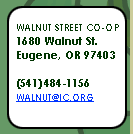Community Revolving
Loan Fund(original version by Tree Bressen, Co-op member 2000-2007) See the 2008 Investor Packet we're using in our current round of refinancing.
Community Revolving Loan Funds are an amazing tool. When we converted our house to cooperative ownership, no bank was willing to offer us a mortgage. Out of necessity we searched for alternatives, and succeeded in purchasing our 9-bedroom home in Eugene, Oregon thanks to approximately 20 friends who invested in our co-op with private loans. This is a fantastic model for alternative financing, a do-it-yourself empowerment that shifts power away from conventional institutions, toward creating a better world. This description is written to make the knowledge our co-op gained from creating this fund available for other groups to benefit.
We have a contract with each lender-investor (we prefer the name investor, since they are at least investing in our social experiment and change work, and most are earning interest, as well). This contract specifies how much money is being invested, for how long, at what interest rate, and any other terms. Our usual parameters are a $5,000 minimum investment, 5 year minimum time, and no more than 6% interest. We aim to be flexible, however, and every contract is a bit different; for example, one investment requires us to maintain an advisory team. Our investors have been very generous with us: some invested at 0% interest, others at 2–3%, and a few are using simple interest rather than compound interest; also some were able to commit for 10–15 years. We offer a way for people to invest in alignment with their values and our investors appreciate that.
Our investments have been in the range of $5,000–20,000, except for one $120,000 investment from a person who met us when we had already raised over half the money we needed and offered to cover the rest. Of course, your experience will differ.
Most of these investment loans are amortized
at 30 years, which makes the payments affordable. If you are new to this scene, amortization means that the payments are stretched out over a really long time. That's how people of limited means are able to buy something big like a house. Thirty years is a typical amortization for a standard home mortgage from a bank. However, unlike a bank, most individuals cannot predict the course of their lives 30 years ahead and therefore are not prepared to commit their assets for that long. So instead the way our investments work is that we make small payments during the 5 years, acting as if it were a 30-year loan. But then at the end of the 5 years, we have to pay the entire remaining balance due—this is called a balloon payment.
That means that every 5 years our community goes through a refinancing cycle. We ask each lender whether they'd like to turn the balance due on their investment back into the fund to invest in us again, or whether they want the money back. We then replace all the investments that people want repaid, either with money from new investors or with increased investments from existing lenders. This is somewhat risky, because if we were unable to find adequate new financing we'd have to sell our property to repay the investments. However, that risk seems very worth it to us, and after our experience so far we are reasonably confident in our ability to do the refinancing. After all, we were able to do it the first time around, and over time we are only going to become a more attractive investment because the community will have more equity in the property and a proven track record of repayment.
Our payments are quarterly rather than monthly, to reduce paperwork.
With the exception of our one large investment, the investments to our co-op are unsecured. That means they are not officially attached to our property in county records, in the event that the co-op dissolves and the house is sold. This is partly because we wanted all of our investors beyond the one large investment to share an "equal second" position: meaning that if the house was sold and the money wasn't enough to pay back all the investors, everyone would get a proportion equal to the portion of their investment, to be fair. But when investments are secured with the property, they get priority in the sequence in which they were recorded with the county, so that all of A's investment is paid off before B gets anything. In order to give everyone an equal position we would have had to form a whole separate legal entity, and even then the lawyer we talked to wasn't sure it was doable. Also, having 20 separate investments attached to a property is very complicated, especially when the investors change over the years. So instead, our investments are unsecured, and the contract with each investor explains that they are in an equal second position with other investors. In the future we may, however, write individual contracts to give second or even third position to other specific major investors.
Some of the investments have co-op members signed as personal guarantors. That means that if the co-op fails to make payments, each of those guarantors can be held responsible for the entire remaining balance of the investment. But even with that, what it really comes down to is that this whole community revolving loan fund deal is based on trust. Our lenders understand that we are committed to being in integrity with them, and that while we don't expect our co-op to fall apart, if it does we will do our utmost to fulfill our financial obligations. If the co-op dissolves, outside investors get paid in full before any co-op residents get paid anything. Because our house has been appraised at nearly $200,000 more than we paid for it and real estate values in our town are rising, it is extremely unlikely that we'd be unable to repay all the investments even if we did have to sell the property.
Our investors come from a variety of sources. Some are active folks in the intentional communities movement who believe in creating more intentional communities. Some are personal friends who felt moved to support a particular individual here. Some are supporters of a wonderful non-profit that lives here, the Co-Intelligence Institute. We also received support from several organizations in the communities movement.
We attend to our relationships with our investors; they are our friends and not just a source of financing. We strive to be honest with them, offering genuine appreciation and practical information without distortion or descent into puffery. We send them a quarterly newsletter along with their checks, explain to newer housemates who they are as people, and have occasionally visited them and some of them have visited us. Our investors are a valuable part of our wider community and we are very grateful for their continued support.
When we started this fund, we created a beautiful, well-written packet that explained our project to prospective lenders, and we revise it for each new reinvestment period. Click here to download a pdf of the current version. The packet includes:
- A vision of what we are doing and why it matters
- History of our project and community
- A description of who we are, how we live, and how we contribute to the world
- Biographies of the core group / board members
- An explanation of what a co-op is and what type of community we are, and our place in the larger co-op / intentional community movements
- Testimonial letter from a satisfied investor
- Photos of the house (interior and exterior, with co-op founders in some of the pictures)
- Financial information—financial report, budget, list of current investors, their quarterly interest rates and payments, and when they need to be repaid
- Form for enrolling support (investments, donations, and more)
- SASE (self-addressed stamped envelope)
If you are setting out to create a Community Revolving Loan Fund for your intentional community or other project, our core advice is as follows:
- Believe in what you are doing and share your passion.
- Have everyone in your project make a list of everyone they know that has $5,000 or more (or whatever your minimum investment is) that they might be able to invest. Hopefully you will be surprised by how many names are on the list. You won't end up asking everyone on that list, but it gets you started seeing the possibilities.
- Keep firmly in mind that you are offering investors a service and an opportunity. You are helping them to live out their values in the world. At 3% interest you would be providing a higher profit than a savings account and a more reliable profit than many other investments, especially in today's economy.
- It's all based on trust. Some people invested in us based on one conversation without ever seeing the packet, simply because they believed in the person asking. At first we were surprised by this, but then came to understand that trust is the central element in a investor's decision. Be honest, transparent, and above all always act with integrity.
Click here to see a sample contract.
Other possible financing sources for intentional community land acquisition
include:
- Institute for Community Economics (ICE): Their bureaucratic wheels turn slowly and they require huge amounts of documentation, but they can
lend over $100,000 if your project is structured as a land trust or limited equity cooperative.
- PEACH (Protected Equity Accessible for Community Health): The member
communities of the Federation of Egalitarian Communities (FEC) operate their own health risk fund, a portion of which is available for investment
in intentional communities. This is a great cooperative
resource. Contact the PEACH administrator, Laird Schaub, for more
information at laird@ic.org or 660-883-5545.
- Sunrise Credit Union is the only credit union in the U.S. based in an intentional community (Sunrise Ranch in Loveland, CO). Credit unions,
especially young ones, are closely monitored by federal agencies so they
are somewhat limited in their flexibility, however they offered us a
substantial loan if we proffered a qualified co-signer.
- Permaculture Credit Union: This is an even newer credit union, and they are not set up to lend in very many states yet, but you can contact
them to find out if they are a resource in your area.
- NASCO (North American Students of Cooperation) lends money to cooperatives that fit current lending parameters, through their CCDC development company.
- In theory the National Cooperative Bank should be a source of financing for projects like this, but we were told we were too small for them to even consider. However, if you are converting an apartment building in New York to a co-op, they'd probably be interested.
- You can try asking other intentional communities and intentional
community organizations, particularly ones in your region.
Walnut Street's Community Revolving Loan Fund was inspired and assisted by a
similar entity at Los Angeles Eco-Village. Their fund is outlined at the LAEV website.
back to top
|











